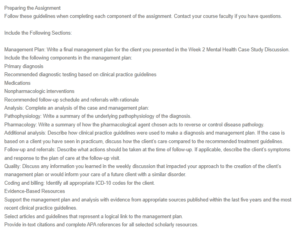Discussion – General Anxiety Disorder(GAD)
Management Plan
Primary Diagnosis
The client was diagnosed with generalized anxiety disorder (GAD). The recommended diagnostic testing based on clinical practice guidelines will include combining the Beck Anxiety Inventory (BAI) with the General Health Questionnaire (GHQ-12) to fully differentiate between anxiety and depression symptoms.
Medications
Nonpharmacologic Interventions
The nonpharmacologic intervention selected as first-line intervention is cognitive behavioral therapy (CBT). CBT will be delivered in 15 45-minute sessions planned for every Tuesday and Friday. The nonpharmacologic was also to be combined with Duloxetine 60mg to be taken orally once a day.
Recommended Follow-Up Schedule and Referrals with Rationale
The management plan will include follow-up appointments scheduled for every two weeks after the first week since the start of the treatment plan has been implemented for the next three months. The rationale for the follow-up includes the need to assess the progress achieved and side effects and make necessary adjustments in the management plan.
The referrals for the client include a referral to a CBT specialist and a psychiatrist. The CBT specialist will provide specialized GAD care while the psychiatrist will further evaluate the client and provide suggestions for CBT and duloxetine. Specialized mental care is related to better outcomes and higher satisfaction levels among mental health patients, including GAD (Fortin et al., 2018),
Analysis
Pathophysiology
GAD development is associated with the dysregulation of serotonergic and noradrenergic neurotransmitter systems, leading to persistent worry and distress (Almokhtar et al., 2019). Anxiety symptoms can further develop due to functional abnormalities in the amygdala and prefrontal cortex (Kenwood et al., 2021).
Pharmacology
Like other SSRIs, duloxetine acts by inhibiting the reuptake of serotonin and norepinephrine in the brain, improving the availability of these neurotransmitters, hence, better moods and mitigation of anxiety symptoms (Almokhtar et al., 2019).
Additional Analysis
The Anxiety & Depression Association of America (ADAA) guidelines were used to determine symptoms for GAD diagnosis, the recommended first-line interventions, and medication options, including dosage and rate. The client’s care aligned with the ADAA recommendations.
Follow-Up and Referrals
The follow-up should focus on treatment response, side effects, and overall functioning of the patient and make recommendations for future care.
Quality
I learned that combining pharmacotherapy and psychotherapy can help address symptoms and underlying factors, leading to better care quality and long-term outcomes.
Coding and Billing
ICD-10 codes for GAD: F41.1.
References
Almokhtar, A. A., Jbireal, J. M., & Azab, A. E. (2019). Anxiety: Insights into signs, symptoms, etiology, pathophysiology, and treatment. East African Scholars Journal of Medical Sciences, 2(10).
Fortin, M., Zhirong, C., & Fleury, M. J. (2018). Satisfaction with primary and specialized mental health care among patients with mental disorders. International Journal of Mental Health, 47(2), 97–117. https://doi.org/10.1080/00207411.2018.1448661
Kenwood, M. M., Kalin, N. H., & Barbas, H. (2021). The prefrontal cortex, pathological anxiety, and anxiety disorders. Neuropsychopharmacology 2021 47:1, 47(1), 260–275. https://doi.org/10.1038/s41386-021-01109-z
ORDER A PLAGIARISM-FREE PAPER HERE
We’ll write everything from scratch
Question
Preparing the Assignment
Follow these guidelines when completing each component of the assignment. Contact your course faculty if you have questions.

Discussion – General Anxiety Disorder
Include the Following Sections:
Management Plan: Write a final management plan for the client you presented in the Week 2 Mental Health Case Study Discussion. Include the following components in the management plan:
Primary diagnosis
Recommended diagnostic testing based on clinical practice guidelines
Medications
Nonpharmacologic interventions
Recommended follow-up schedule and referrals with rationale
Analysis: Complete an analysis of the case and management plan:
Pathophysiology: Write a summary of the underlying pathophysiology of the diagnosis.
Pharmacology: Write a summary of how the pharmacological agent chosen acts to reverse or control disease pathology.
Additional analysis: Describe how clinical practice guidelines were used to make a diagnosis and management plan. If the case is based on a client you have seen in practicum, discuss how the client’s care compared to the recommended treatment guidelines.
Follow-up and referrals: Describe what actions should be taken at the time of follow-up. If applicable, describe the client’s symptoms and response to the plan of care at the follow-up visit.
Quality: Discuss any information you learned in the weekly discussion that impacted your approach to the creation of the client’s management plan or would inform your care of a future client with a similar disorder.
Coding and billing: Identify all appropriate ICD-10 codes for the client.
Evidence-Based Resources
Support the management plan and analysis with evidence from appropriate sources published within the last five years and the most recent clinical practice guidelines.
Select articles and guidelines that represent a logical link to the management plan.
Provide in-text citations and complete APA references for all selected scholarly resources.

